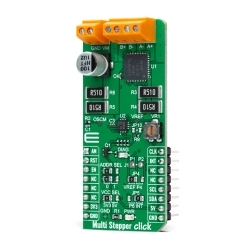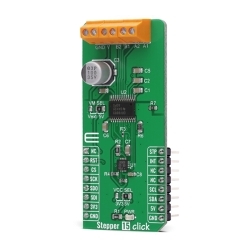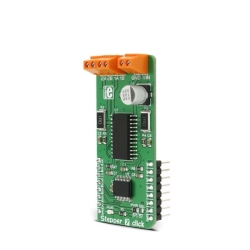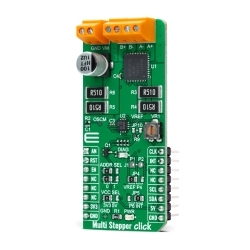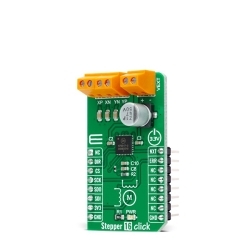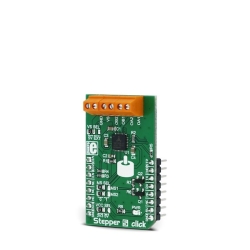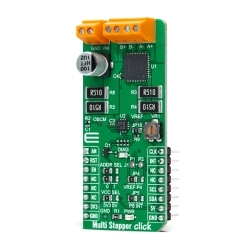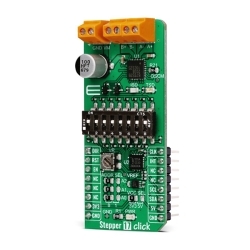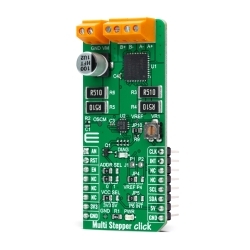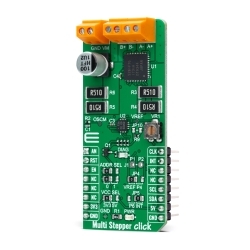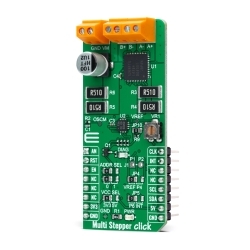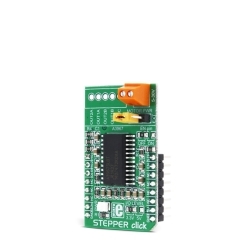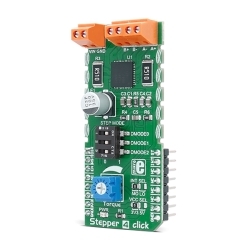MIKROE Stepper 12 Click
Stepper 12 Click is a compact add-on board that contains a bipolar stepper motor driver.
Product Overview
Stepper 12 Click is a compact add-on board that contains a bipolar stepper motor driver. This board features the TB67S549FTG, a two-phase bipolar stepping motor driver from Toshiba Semiconductor. It supports a PWM constant-current control drive without a current sense resistor for motor-current detection owing to the built-in function of the Advanced Current Detect System (ACDS) and allows full-step to 1/32 steps resolution for less motor noise and smoother control. It has a wide operating voltage range of 4.5V to 34V with an output current capacity of 1.5A maximum and several anomaly detection indicators. This Click board™ makes the perfect solution for small stepping motors in various applications such as office automation and commercial and industrial equipment.
Stepper 12 Click as its foundation uses the TB67S549FTG, a two-phase bipolar stepping motor driver designed to control one bipolar stepping motor with resistorless current sensing owing to the built-in function of Advanced Current Detect System (ACDS) from Toshiba Semiconductor. The TB67S549FTG incorporates low on-resistance DMOS FETs, which can deliver a 1.5A maximum current with a motor output voltage rating of 40V and integrated protection mechanisms such as over-current, over-temperature, and under-voltage lockout for error detection (LO LED indicator). It supports full-step to 1/32 steps resolution for less motor noise and smoother control, with Advanced Dynamic Mixed Decay (ADMD) built-in function that helps stabilize the current waveforms.
Thanks to the many steps that TB67S549FTG supports, motor noise can be significantly reduced with smoother operation and more precise control. It is suited to a wide range of applications such as office automation, commercial, and industrial equipment using stepping motors supporting an operational temperature range covering 40°C to +85°C. The current value in the PWM constant-current mode is set by the reference voltage value obtained by the MCP1501, a high-precision voltage regulator. Also, the current threshold point of the TB67S549FTG, alongside MCP1501, can be set manually using an onboard trimmer labeled VR.
In addition to the I2C communication, several GPIO pins connected to the mikroBUS™ socket pins are also used to forward the information to the MCU associated with the PCA9555A port expander. The PCA9555A also allows choosing the least significant bit (LSB) of its I2C peripheral address by positioning SMD jumpers labeled as ADDR SEL to an appropriate position marked as 0 and 1, alongside its interrupt feature routed to the INT pin of the mikroBUS™ socket.
The CLK clock signal, routed to the PWM pin of the mikroBUS™ socket, shifts the current step and electrical angle of the motor with its every up-edge, while the Enable pin, labeled as EN and routed to the CS pin of the mikroBUS™ socket, controls the state of the output A and B stepping motor drive channels. The normal constant current control is started by turning the motor drive ON (HIGH level), while by setting the motor drive OFF, the outputs are turned high impedance because the MOSFETs are set to OFF (LOW level). Besides, all circuits can be stopped using the Sleep function and thus enable power saving mode. A simple DIR pin routed to the AN pin on the mikroBUS™ socket allows MCU to manage the direction of the stepper motor (clockwise or counterclockwise), while the RST pin of the mikroBUS™ socket initializes an electrical angle in the internal counter to set an initial position. Achieving an initial position is indicated via onboard orange LED labeled as MO.
A specific addition to this Click board™ is a multifunctional switch that allows the user, by selecting a particular switch, to set appropriate features such as:
- 1 – Sleep Mode Activation
- 2 , 3 – Motor Torque Setting
- 5 – Decay Control
- 6 , 7 , 8 – Step Resolution Setting
In addition to this physical way of setting these functions, the user can select them digitally via the I2C interface.
The Stepper 12 Click supports an external power supply for the TB67S549FTG, which can be connected to the input terminal labeled as VM and should be within the range of 4.5V to 34V, while the stepper motor coils can be connected to the terminals labeled as B+, B-, A-, and A+.
This Click board™ can operate with both 3.3V and 5V logic voltage levels selected via the VCC SEL jumper. This way, it is allowed for both 3.3V and 5V capable MCUs to use communication lines properly. However, the Click board™ comes equipped with a library containing easy-to-use functions and an example code that can be used, as a reference, for further development.
Features & Specs
- Interface: GPIO, I2C
- Compatibility: mikroBUS™
- Dimensions: 57.15 x 25.4mm
- Input Voltage: 3.3V, 5V, External
- Supply Voltage VCC: Min. 3.3V, Max. 5V
- External Supply Voltage VM: Min. 4.5V, Typ. 24V, Max. 34V
- Maximum Output Voltage: 40V
- Maximum Output Current: 1.5A
- Maximum Step Clock Frequency: 250 kHz
- Operating Temperature Range: Min. -20°C, Typ. +25°C, Max. +85°C
Customer Reviews
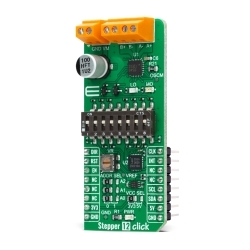
Stock and Customer Discounts
Available Discounts
- $21.80 | 25+ units
- $20.66 | 100+ units


